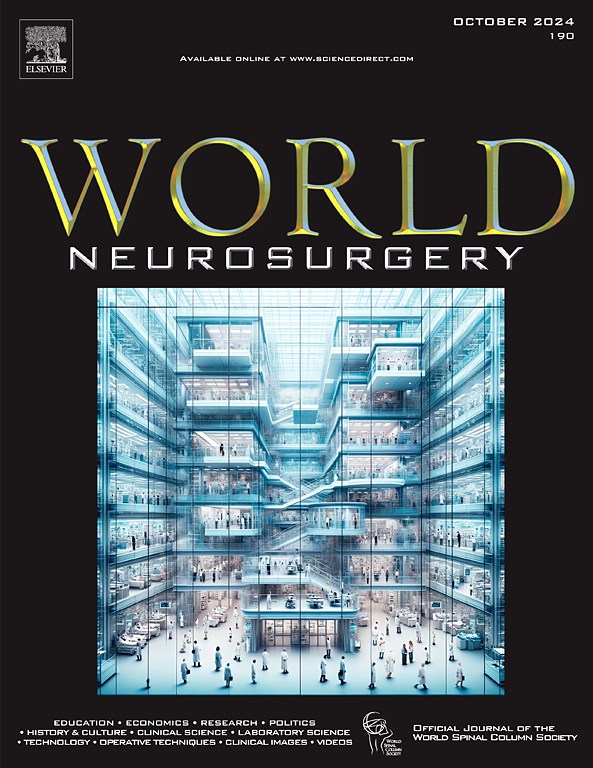Comparison of Single Antiplatelet Therapy and Dual Antiplatelet Therapy in the Treatment of Intracranial Aneurysms with Surface-Modified Flow Diverters: A Systematic Review and Meta-Analysis
IF 2.1
4区 医学
Q3 CLINICAL NEUROLOGY
引用次数: 0
Abstract
Objective
Surface-modified flow diverters enable application of single antiplatelet therapy (SAPT) for intracranial aneurysms (IAs) treatment. This study systematically evaluated the feasibility of SAPT as an alternative to dual antiplatelet therapy (DAPT).
Methods
PubMed, Scopus, and Web of Science were searched for surface-modified flow diverter studies. Two reviewers independently assessed eligibility. Study quality was evaluated using NIH tools and Egger's test. Outcomes were pooled via Freeman-Tukey arcsine transformation, with heterogeneity assessed by I2.
Results
The analysis included 6 SAPT studies (200 patients, 243 aneurysms) and 18 DAPT studies (1553 patients, 1728 aneurysms). All efficacy and safety outcomes—including 6-month complete occlusion rates (77.1% vs. 72.2%), 6-month adequate occlusion rates (86.9% vs. 86.6%), all-cause mortality (0.2% vs. 0.3%), treatment-related mortality (0% vs. 0.1%), morbidity (0% vs. 0.4%), ischemic complications (1.7% vs. 4.6%), thrombosis formation (1.3% vs. 2.3%), and intracranial hemorrhage rates (0% vs. 0.9%)—exhibited no significant differences. For p48/64 MW HPC specifically, the remaining outcomes also exhibited no significant differences, with the exception of lower 6-month adequate occlusion rates in the SAPT group (85.5% vs. 93.8%, P = 0.03). Compared to prasugrel monotherapy and DAPT regimens, aspirin was more economical yet poses higher safety risk.
Limitations
Limitations include the limited sample size of the SAPT group, the retrospective design of most included studies, and significant heterogeneity.
Conclusions
SAPT shows comparable efficacy and safety to DAPT. Prasugrel monotherapy is a more preferable option compared with aspirin. SAPT may be a viable alternative, particularly for high-hemorrhage-risk patients.
单抗血小板治疗与双抗血小板治疗颅内动脉瘤表面修饰血流分流剂的比较:系统综述和meta分析。
目的:表面修饰的血流分流器(smfd)使单抗血小板治疗(SAPT)在颅内动脉瘤(IAs)治疗中的应用成为可能。本研究系统地评估了SAPT作为双重抗血小板治疗(DAPT)替代方案的可行性。方法:检索PubMed、Scopus和Web of Science中SMFD的相关研究。两名审稿人独立评估了资格。使用NIH工具和Egger检验评估研究质量。通过Freeman-Tukey反正弦变换对结果进行汇总,并通过I2评估异质性。结果:纳入6项SAPT研究(200例患者,243个动脉瘤)和18项DAPT研究(1553例患者,1728个动脉瘤)。所有的疗效和安全性结果——包括6个月完全闭塞率(77.1% vs 72.2%)、6个月充分闭塞率(86.9% vs 86.6%)、全因死亡率(0.2% vs 0.3%)、治疗相关死亡率(0% vs 0.1%)、发病率(0% vs 0.4%)、缺血性并发症(1.7% vs 4.6%)、血栓形成(1.3% vs 2.3%)和颅内出血率(0% vs 0.9%)——均无显著差异。对于p48/64 HPC,除了SAPT组6个月足够闭塞率较低(85.5% vs 93.8%, P = .03),其余结果也没有显著差异。与普拉格雷单药治疗和DAPT方案相比,阿司匹林更经济,但存在更高的安全风险。局限性:局限性包括SAPT组的样本量有限,大多数纳入研究的回顾性设计,以及显著的异质性。结论:SAPT与DAPT的疗效和安全性相当。与阿司匹林相比,普拉格雷单药治疗是更可取的选择。SAPT可能是一种可行的替代方案,特别是对高危患者。
本文章由计算机程序翻译,如有差异,请以英文原文为准。
求助全文
约1分钟内获得全文
求助全文
来源期刊

World neurosurgery
CLINICAL NEUROLOGY-SURGERY
CiteScore
3.90
自引率
15.00%
发文量
1765
审稿时长
47 days
期刊介绍:
World Neurosurgery has an open access mirror journal World Neurosurgery: X, sharing the same aims and scope, editorial team, submission system and rigorous peer review.
The journal''s mission is to:
-To provide a first-class international forum and a 2-way conduit for dialogue that is relevant to neurosurgeons and providers who care for neurosurgery patients. The categories of the exchanged information include clinical and basic science, as well as global information that provide social, political, educational, economic, cultural or societal insights and knowledge that are of significance and relevance to worldwide neurosurgery patient care.
-To act as a primary intellectual catalyst for the stimulation of creativity, the creation of new knowledge, and the enhancement of quality neurosurgical care worldwide.
-To provide a forum for communication that enriches the lives of all neurosurgeons and their colleagues; and, in so doing, enriches the lives of their patients.
Topics to be addressed in World Neurosurgery include: EDUCATION, ECONOMICS, RESEARCH, POLITICS, HISTORY, CULTURE, CLINICAL SCIENCE, LABORATORY SCIENCE, TECHNOLOGY, OPERATIVE TECHNIQUES, CLINICAL IMAGES, VIDEOS
 求助内容:
求助内容: 应助结果提醒方式:
应助结果提醒方式:


